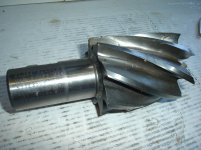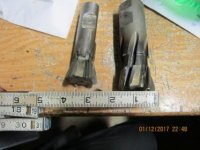Hello all,
I'm trying to make multiple dovetail dies for a sheetmetal powerhammer. I'd like to gang up several blanks of 2x2 stock and cut the dovetails all at once. I was advised to have a wheel cutter reground, perhaps even an old, dull cutter found on fleabay since it will require grinding regardless. Can anyone advise me on the parameters of tool I should be looking for. I need to make a 1" tall dovetail with a 10 degree angle. I would also like any recommendations for a shop that would take on the grinding work.
I have access to a large WWII era Cincinatti Mill with a vertical head at a local machine shop. Will I require a certain type of arbor? Any insight would be appreciated.
-Adair
I'm trying to make multiple dovetail dies for a sheetmetal powerhammer. I'd like to gang up several blanks of 2x2 stock and cut the dovetails all at once. I was advised to have a wheel cutter reground, perhaps even an old, dull cutter found on fleabay since it will require grinding regardless. Can anyone advise me on the parameters of tool I should be looking for. I need to make a 1" tall dovetail with a 10 degree angle. I would also like any recommendations for a shop that would take on the grinding work.
I have access to a large WWII era Cincinatti Mill with a vertical head at a local machine shop. Will I require a certain type of arbor? Any insight would be appreciated.
-Adair








